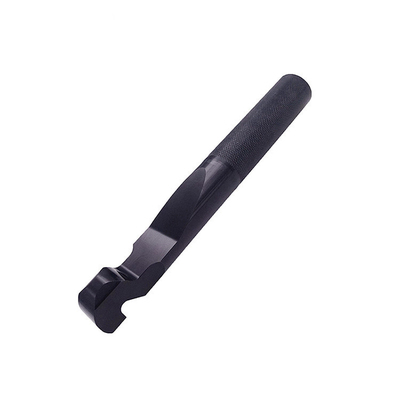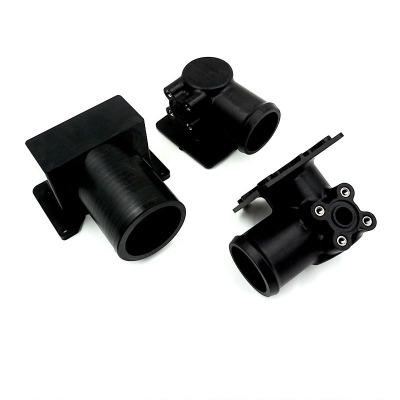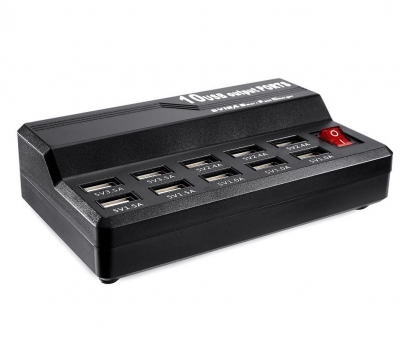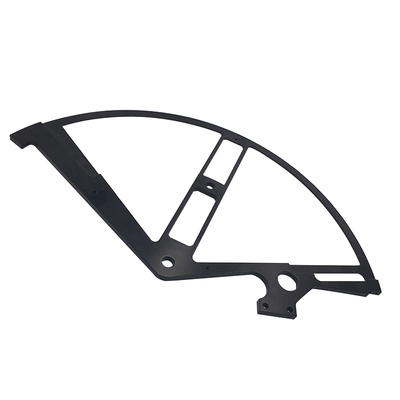Ten Common Problems In CNC Machining Process
Starting from the actual production, this article summarizes the common problems and improvement methods of CNC machining process, and how to choose the three important factors of speed, feed rate and cutting depth in different application areas for your reference.
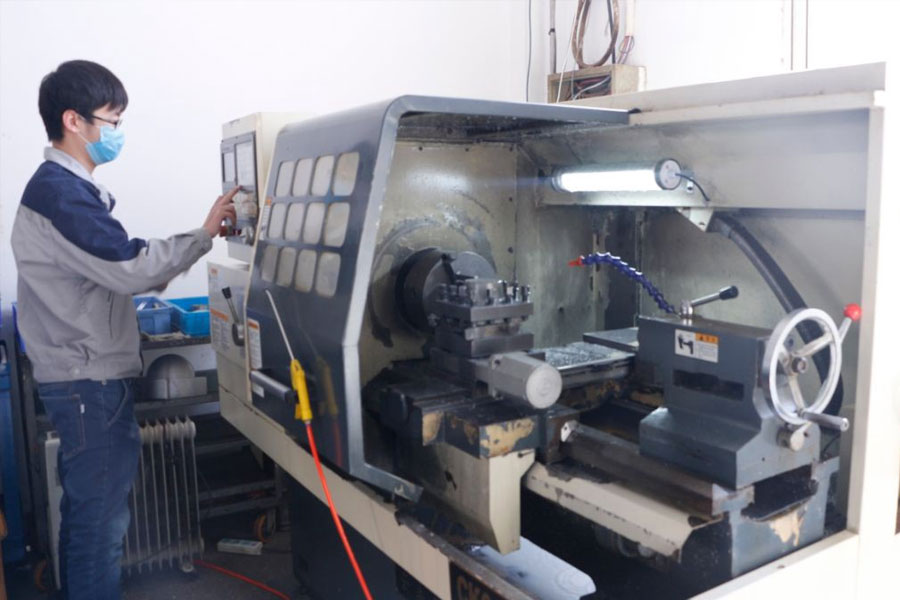
1.The workpiece is overcut
reason:
- 1. Bounce the knife, the tool strength is not too long or too small, causing the tool to bounce.
- 2. Improper operation by the operator.
- 3. Uneven cutting allowance (for example: 0.5 on the side surface of the curved surface and 0.15 on the bottom surface)
- 4. Improper cutting parameters (such as: tolerance is too large, SF setting is too fast, etc.)
improve:
- 1. The principle of knife use: can be big but not small, can be short but not long.
- 2. Add the corner cleaning program, and leave the margin as evenly as possible (the margin on the side and bottom is the same).
- 3. Reasonably adjust cutting parameters, and round corners with large margins.
- 4. Using the SF function of the machine tool, the operator fine-tunes the speed to achieve the best effect of machine cutting.
2.The problem of dividing the middle
reason:
- 1. Inaccurate during manual operation by the operator.
- 2. There are burrs around the mold.
- 3. The center rod has magnetism.
- 4. The four sides of the mold are not vertical.
improve:
- 1. Manual operation should be carefully checked repeatedly, and the points should be at the same point and height as much as possible.
- 2. Deburr the periphery of the mold with oilstone or a file, wipe it clean with a rag, and finally confirm it by hand.
- 3. Demagnetize the centering rod before centering the mold (ceramic centering rod or others can be used).
- 4. Calibrate to check whether the four sides of the mold are vertical (large vertical error requires reviewing the plan with the fitter).
3.The problem of knife setting
reason:
- 1. Inaccurate during manual operation by the operator.
- 2. The tool is incorrectly clamped.
- 3. The blade on the flying knife is wrong (the flying knife itself has a certain error).
- 4. There is an error between the R knife and the flat-bottom knife and the flying knife.
improve:
- 1. Manual operation should be carefully checked repeatedly, and the tool setting should be at the same point as much as possible.
- 2. When the tool is clamped, blow it with an air gun or wipe it with a rag.
- 3. One blade can be used when the upper blade of the flying knife needs to be measured on the shank and the bottom surface is light.
- 4. A separate tool setting program can avoid the error between R knife, flat knife and flying knife.
4.Collision-programming
reason:
- 1. The safety height is insufficient or not set (the tool or the chuck hits the workpiece during rapid traverse G00).
- 2. The tool on the program sheet and the actual program tool are written incorrectly.
- 3. The tool length (blade length) on the program sheet and the actual machining depth are wrongly written.
- 4. The depth Z-axis access and the actual Z-axis access on the program sheet are incorrectly written.
- 5. The coordinates are set incorrectly during programming.
improve:
- 1. Accurate measurement of the height of the workpiece also ensures that the safety height is above the workpiece.
- 2. The tool on the program list should be consistent with the actual program tool (try to use the automatic program list or the picture to list the program list).
- 3. Measure the actual machining depth on the workpiece, and write clearly the length and blade length of the tool on the program sheet (generally, the length of the tool holder is 2-3MM higher than the workpiece, and the blade length is 0.5-1.0MM).
- 4. Take the actual number of Z-axis on the workpiece, and write it clearly on the program sheet. (This operation is generally written manually and needs to be checked repeatedly).
5.Collision-operator
reason:
- 1. The tool setting error of the depth Z axis.
- 2. The number of hits and operations in the division are wrong (such as: there is no infeed radius in the unilateral fetching, etc.).
- 3. Use the wrong tool (for example: D4 tool is processed with D10 tool).
- 4. The program went wrong (for example: A7.NC went A9.NC).
- 5. The handwheel is turned in the wrong direction during manual operation.
- 6. Press the wrong direction during manual rapid traverse (for example: -X press +X).
improve:
- 1. For depth Z axis tool setting, you must pay attention to the position of the tool. (Bottom surface, top surface, analysis surface, etc.).
- 2. Check repeatedly after the count and the operation are completed.
- 3. When clamping the tool, check it repeatedly with the program list and the program before loading it.
- 4. The program should be run in order one by one.
- 5. When using manual operation, the operator himself should strengthen the operation proficiency of the machine tool.
- 6. In manual rapid traverse, you can first raise the Z axis to the top of the workpiece to move.
6.Surface accuracy
reason:
- 1. The cutting parameters are unreasonable, and the surface of the workpiece is rough.
- 2. The cutting edge of the tool is not sharp.
- 3. The tool clamping is too long, and the blade is too long to avoid the air.
- 4. Chip removal, air blowing and oil flushing are not good.
- 5. Program the way of tool movement (you can consider down milling as much as possible).
- 6. The workpiece has burrs.
improve:
- 1. The cutting parameters, tolerances, margins, and speed feed settings should be reasonable.
- 2. The tool requires the operator to inspect and replace it irregularly.
- 3. When clamping the tool, the operator is required to clamp as short as possible, and the cutting edge should not be too long.
- 4. For flat knives, R knives, and round nose knives, the speed and feed settings should be reasonable.
- 5. The workpiece has burrs: it is directly related to our machine tools, cutting tools, and cutting methods. So we have to understand the performance of the machine tool and make up the edges with burrs.
7.Chipping
Reasons and improvements:
1) Feed too fast
--Slow down to a suitable feed rate
2)Feed too fast at the beginning of cutting
- Slow down the feed rate at the beginning of cutting
3)Loose clamping (tool)
--Clamping
4) Loose clamping (workpiece)
--Clamping
5)Insufficient rigidity (tool)
--Use the shortest tool allowed, clamp the shank deeper, and try down milling
6)The cutting edge of the tool is too sharp
--Change the fragile cutting edge angle, one-time edge
7)Insufficient rigidity of machine tool and tool holder
--Use a rigid machine tool and tool holder
8. Wear
Reasons and improvements:
1)The machine speed is too fast
--Slow down and add enough coolant
2)Hardened material
--Use advanced cutting tools and tool materials to increase the surface treatment method
3)Chip adhesion
--Change the feed rate, chip size or use cooling oil or air gun to clean the chips
4)Improper feed rate (too low)
--Increase the feed rate, try down milling
5)Inappropriate cutting angle
--Change to the appropriate cutting angle
6)The one-time clearance angle of the tool is too small
--Change to a larger rear angle
9.Destruction
Reasons and improvements:
1)Feed too fast
--Slow down the feed rate
2) The cutting amount is too large
--Use a smaller cutting amount per edge
3)The blade length and overall length are too large
--Clip the shank deeper, use a short tool, try down milling
4) Too much wear
--Re-grind at the beginning
10. Vibration marks
Reasons and improvements:
1)Feed and cutting speed is too fast
-Correct the feed and cutting speed
2)Insufficient rigidity (machine tool and tool holder)
--Use better machine tools and tool holders or change cutting conditions
3)The back angle is too large
--Change to a smaller relief angle, and process the cutting edge (grind the edge with oil stone once)
4)Loose clamping
--Clamp the workpiece
◆ Consider speed and feed
The interrelationship of the three factors of speed, feed and depth of cut is the most important factor in determining the cutting effect. Improper feed and speed often lead to reduced production, poor workpiece quality, and large tool damage.
Use low speed range for:
- - High hardness materials
- - Wayward material
- - Difficult to cut materials
- - Heavy cutting
- - Minimal tool wear
- - Longest tool life
- - Use high speed range for
- - Soft material
- - Better surface quality
- - Smaller tool outer diameter
- - Light cutting
- - Brittle workpieces
- - Manual operation
- - Maximum processing efficiency
- - Non-metallic materials
- - Use high feed for
- - Heavy and rough cutting
- - Steel structure
- - Easy-to-process materials
- - Roughing tool
- - Plane cutting
- - Low tensile strength material
- - Coarse cutter
- - Use low feed for
- - Light machining, fine cutting
- - Brittle structure
- - Difficult to process materials
- - Small tool
- - Deep vertical groove processing
- - High tensile strength material
- - Finishing tool
Link to this article:Ten Common Problems In CNC Machining Process
Reprint Statement: If there are no special instructions, all articles on this site are original. Please indicate the source for reprinting:https://www.cncmachiningptj.com/,thanks!
 3, 4 and 5-axis precision CNC machining services for aluminum machining, beryllium, carbon steel, magnesium, titanium machining, Inconel, platinum, superalloy, acetal, polycarbonate, fiberglass, graphite and wood. Capable of machining parts up to 98 in. turning dia. and +/-0.001 in. straightness tolerance. Processes include milling, turning, drilling, boring, threading, tapping, forming, knurling, counterboring, countersinking, reaming and laser cutting. Secondary services such as assembly, centerless grinding, heat treating, plating and welding. Prototype and low to high volume production offered with maximum 50,000 units. Suitable for fluid power, pneumatics, hydraulics and valve applications. Serves the aerospace, aircraft, military, medical and defense industries.PTJ will strategize with you to provide the most cost-effective services to help you reach your target,Welcome to Contact us ( [email protected] ) directly for your new project.
3, 4 and 5-axis precision CNC machining services for aluminum machining, beryllium, carbon steel, magnesium, titanium machining, Inconel, platinum, superalloy, acetal, polycarbonate, fiberglass, graphite and wood. Capable of machining parts up to 98 in. turning dia. and +/-0.001 in. straightness tolerance. Processes include milling, turning, drilling, boring, threading, tapping, forming, knurling, counterboring, countersinking, reaming and laser cutting. Secondary services such as assembly, centerless grinding, heat treating, plating and welding. Prototype and low to high volume production offered with maximum 50,000 units. Suitable for fluid power, pneumatics, hydraulics and valve applications. Serves the aerospace, aircraft, military, medical and defense industries.PTJ will strategize with you to provide the most cost-effective services to help you reach your target,Welcome to Contact us ( [email protected] ) directly for your new project.

- 5 Axis Machining
- Cnc Milling
- Cnc Turning
- Machining Industries
- Machining Process
- Surface Treatment
- Metal Machining
- Plastic Machining
- Powder Metallurgy Mold
- Die Casting
- Parts Gallery
- Auto Metal Parts
- Machinery Parts
- LED Heatsink
- Building Parts
- Mobile Parts
- Medical Parts
- Electronic Parts
- Tailored Machining
- Bicycle Parts
- Aluminum Machining
- Titanium Machining
- Stainless Steel Machining
- Copper Machining
- Brass Machining
- Super Alloy Machining
- Peek Machining
- UHMW Machining
- Unilate Machining
- PA6 Machining
- PPS Machining
- Teflon Machining
- Inconel Machining
- Tool Steel Machining
- More Material

